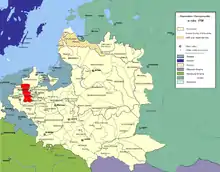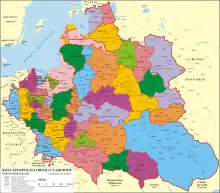| Gniezno Voivodeship | |||||||||
|---|---|---|---|---|---|---|---|---|---|
| Voivodeship of Poland¹ | |||||||||
| 1768–1793 | |||||||||
 Coat of arms
| |||||||||
 Gniezno Voivodeship in the Polish–Lithuanian Commonwealth in 1768. | |||||||||
| Capital | Gniezno | ||||||||
| Area | |||||||||
• | 7,660 km2 (2,960 sq mi) | ||||||||
| History | |||||||||
| 1768 | |||||||||
| 1772 | |||||||||
| 25 September 1793 | |||||||||
| Political subdivisions | Counties: 3 | ||||||||
| |||||||||
| ¹ Voivodeship of the Polish Crown in the Polish–Lithuanian Commonwealth | |||||||||
Gniezno Voivodeship (Polish: Województwo Gnieźnieńskie, Latin: Palatinatus Gnesnensis) was a unit of administrative division and local government in Poland for a short time from 1768, when it was cut from the Kalisz Voivodeship, to the Second Partition of Poland in 1793. It was part of Greater Polish prowincja.
Greater Poland general governor (Starosta Generalny) seat:
Voivodeship governor (wojewoda) seat:
General council (Sejmik Generalny) for the Greater Poland seat:
Administrative division:
- Gniezno County (Powiat Gnieźnieński), Gniezno
- Kcynia County (Powiat Kcyński), Kcynia
- Naklo County (Powiat Nakielski), Nakło
Neighbouring Voivodeships:
This article is issued from Wikipedia. The text is licensed under Creative Commons - Attribution - Sharealike. Additional terms may apply for the media files.
